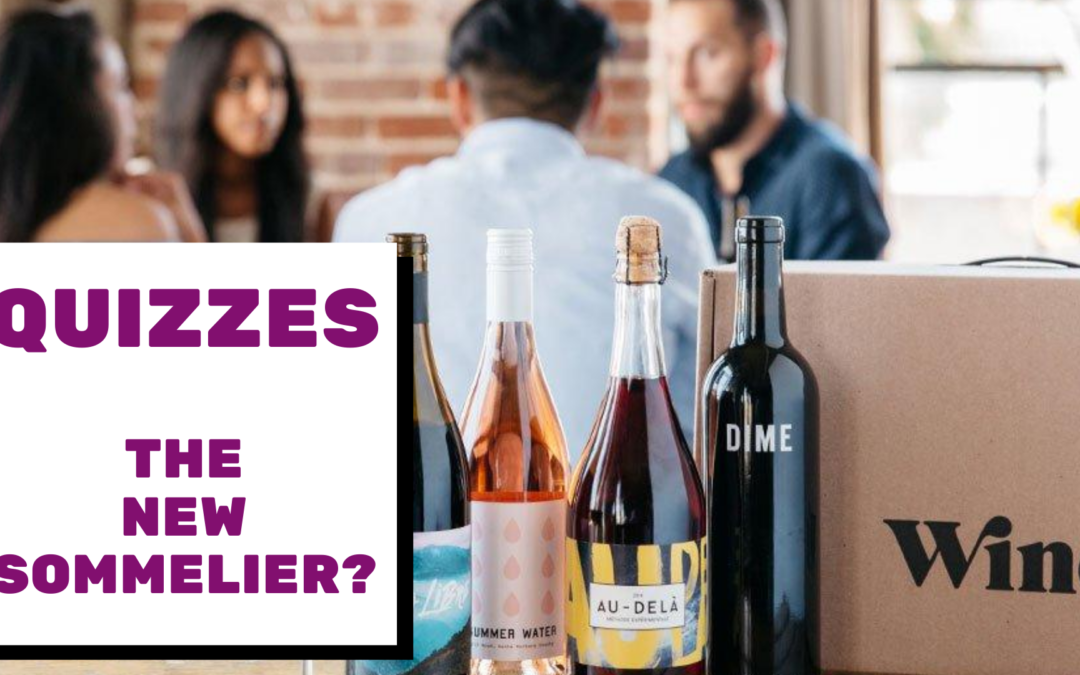In the beginning of the COVID-19 quarantine, liquor stores were “essential businesses” in nearly every US state. They were allowed to remain open for business, as it would have been dangerous to force alcohol-dependent people to withdraw from alcohol, particularly when hospital resources were so needed.
If you need an alcoholic beverage, and you need to shelter-in-place, it is not surprising that online sales of alcohol also skyrocketed.
Online wine sales are growing quickly — in 2019, Direct-To-Consumer wine sales represent $3.2 billion, or 10.8% of all retail sales. This is up from $200 million in 2018, just 0.8% of retail sales.
One company that is changing the game of ecommerce wine sales is Winc.
In this post, we’ll dig in to how Winc (and rival Firstleaf):
- use quizzes to generate leads
- how quizzes create a connection to customer feedback
- position a takeover of a $70BN industry
Wine Goes Digital: How Quizzes Gather Valuable Data
For younger digitally-native demographics, the growth of wine consumption has slowed.
Whether the higher costs of wine, the alternatives of White Claw and consumer-friendly spritzers, or reduced alcohol consumption overall, wine brands need to find a way to appeal to younger consumers.
DTC wine brands have turned to quizzes as the foundation for their customer acquisition strategy.
Quizzes are the top of the funnel, guiding shoppers at the top of the funnel, capturing the email address, and recommending the ideal product pairing.
Not surprisingly, an online sommelier is the most appropriate analogy–the quiz helps to identify the tastes and preferences of the customer, and recommend the most appropriate bottle of wine.
The value proposition of a quiz is therefore straightforward–ask the consumer a few simple questions, and surface a recommendation.
However, the true power of the quiz for DTC wine brands is that it lays the foundation for gathering everything about a customer’s likes, dislikes, and preferences.
Do you like earthy, acidic, fruit-forward, red or white? The average consumer may not know the answers to these questions, but they do know if they like mushrooms or how they like their chocolate.
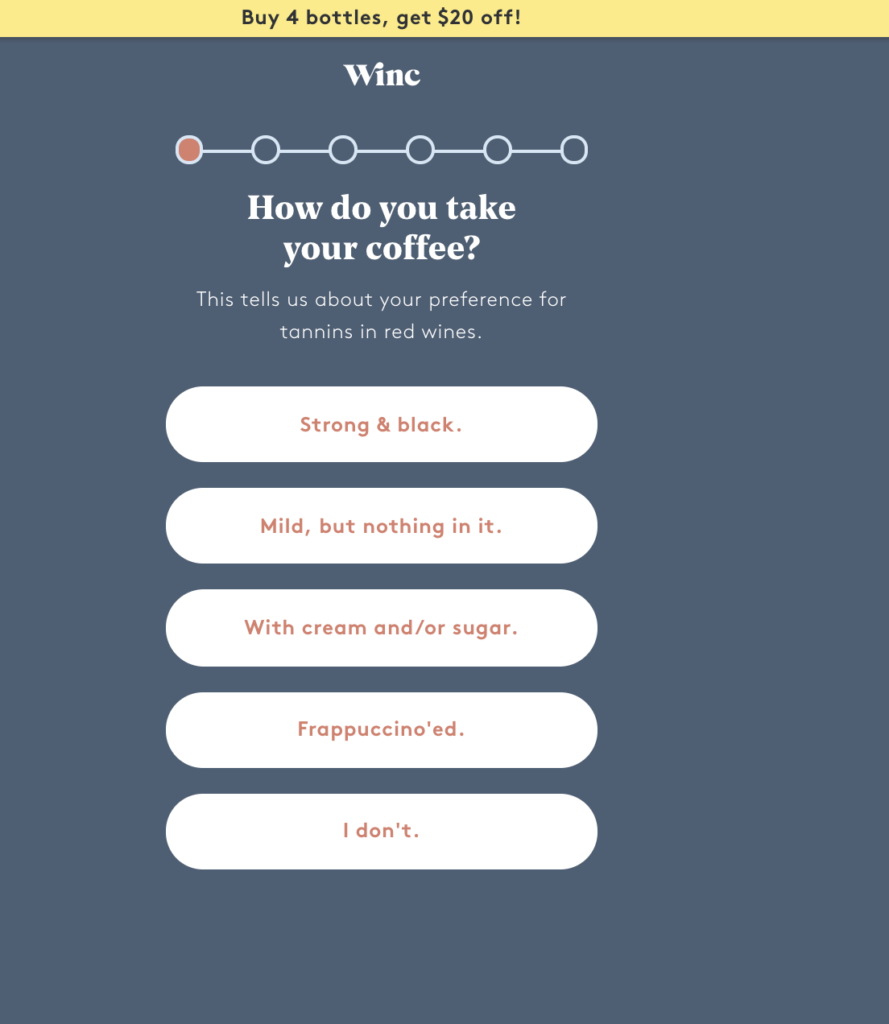
And a consumer can also objectively rate how they like any given wine once they actually taste it.
The quiz is the easy and engaging way to give feedback on personal preference and taste. Every piece of feedback and taste preference becomes a data point to create a taste profile down to the individual level.
This is how Firstleaf matches customers to the perfect bottle of wine: “By adding in a specific member’s likes and dislikes to the algorithm, the program is able to group and measure the relevant information and make recommendations for that club member, running thousands of outcomes in less than a second.”
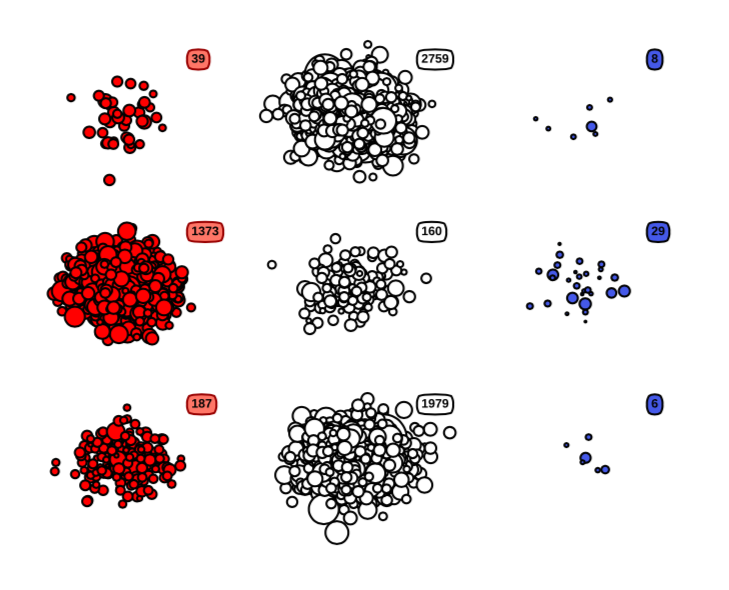
Source – Firstleaf
The DTC Wine Landscape & Winc
The DTC wine market is huge. The total addressable wine and spirits market is $70BN, — bigger than razors ($3Bn), mattresses ($14Bn), skincare ($18Bn), and luggage ($27Bn) combined.
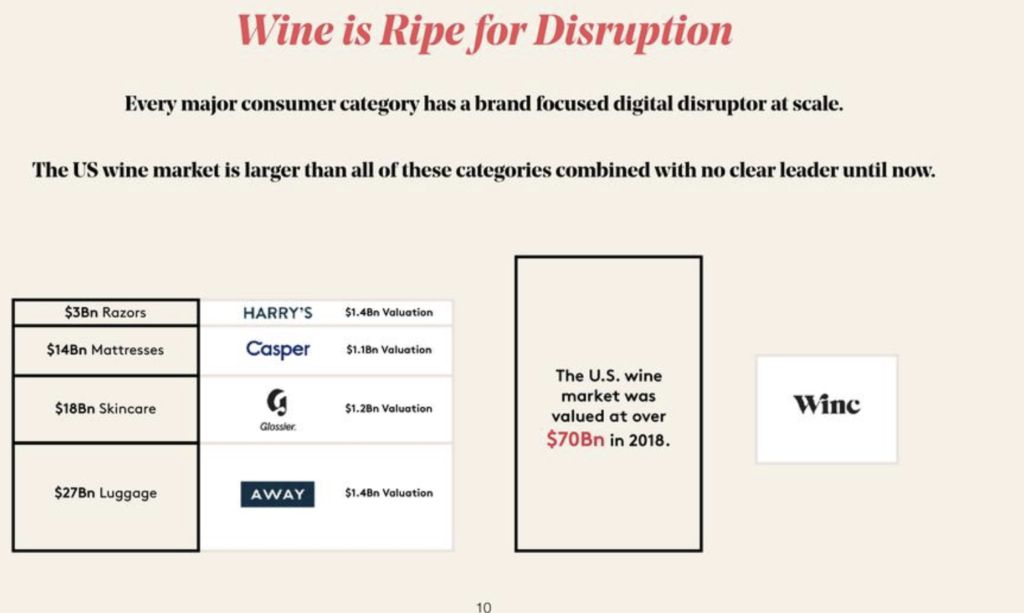
source: Seedinvest
Winc was a pioneer in the space, and a leader. Founded in 2011 as Club W, Winc has raised $43.9 M, most recently a public $15M Series D funding at a $110M valuation. The funds were raised publicly, and all of the juicy details are here.
Why Winc Owns The Whole Supply Chain
Winc differentiates itself from other wine subscription box services by owning the entire supply chain–the wine production, the branding, and the distribution. Instead of buying third-party wines and reselling them, Winc makes its own wines and markets them under its own brands. This is how they can fulfill their promise of higher quality wines at lower prices.
Winc is innovating on the idea of iterative wine making. The strategy is to create wine selections specific to the tastes of their customer base.
By continually monitoring feedback from customers, the company is able to discern trends in order to come up with new wines, and make adjustments to existing formulations in order to satisfy its customers’ palates.
While traditional wine brands optimize around shelf space, Winc optimizes for the consumer focus. This allows more adaptability and scale.
Why Winc Collects Every Data Point
Winc describes itself as a “data-driven winery”. As unsexy as this sounds, it is a very appealing business opportunity.
Here’s how it’s different: Winc is consistently building a huge database of feedback on their wines (specifically the (3.5M+ real time ratings from 542K+ members). Winc can therefore create a wine that fits their customer’s exact flavor preferences. They have a huge base of millennial customers, and additional nationwide distribution in stores like Whole Foods, Vons and national restaurant chains.
It all begins with their quiz, which they call the Palate Profile Quiz. With six simple questions (which can be answered in less than a minute), Winc can quickly identify your wine preferences. Then you are offered a curated selection of wines based on these preferences, confirm the order, and they are delivered to your door.
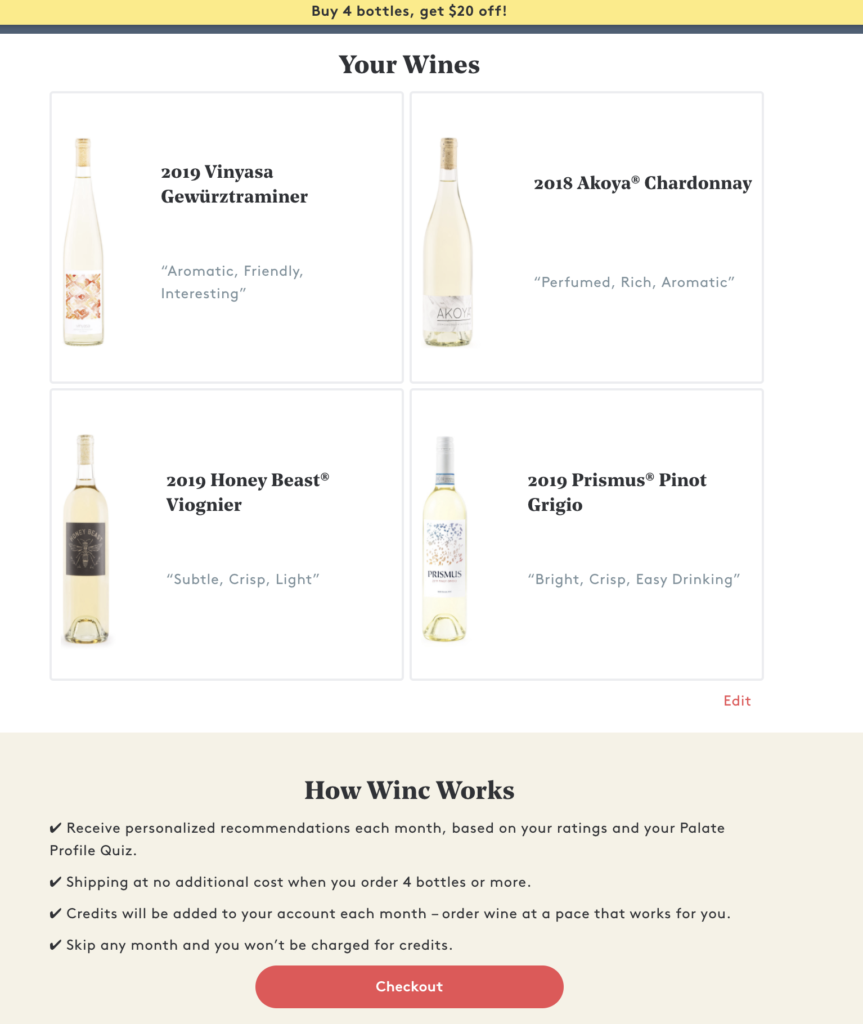
My Search For A Wine Brand: The Quiz Experience
I have never bought wine before, so naturally I start my search with a non-branded search term, and look for the top results:
This is my Google search:
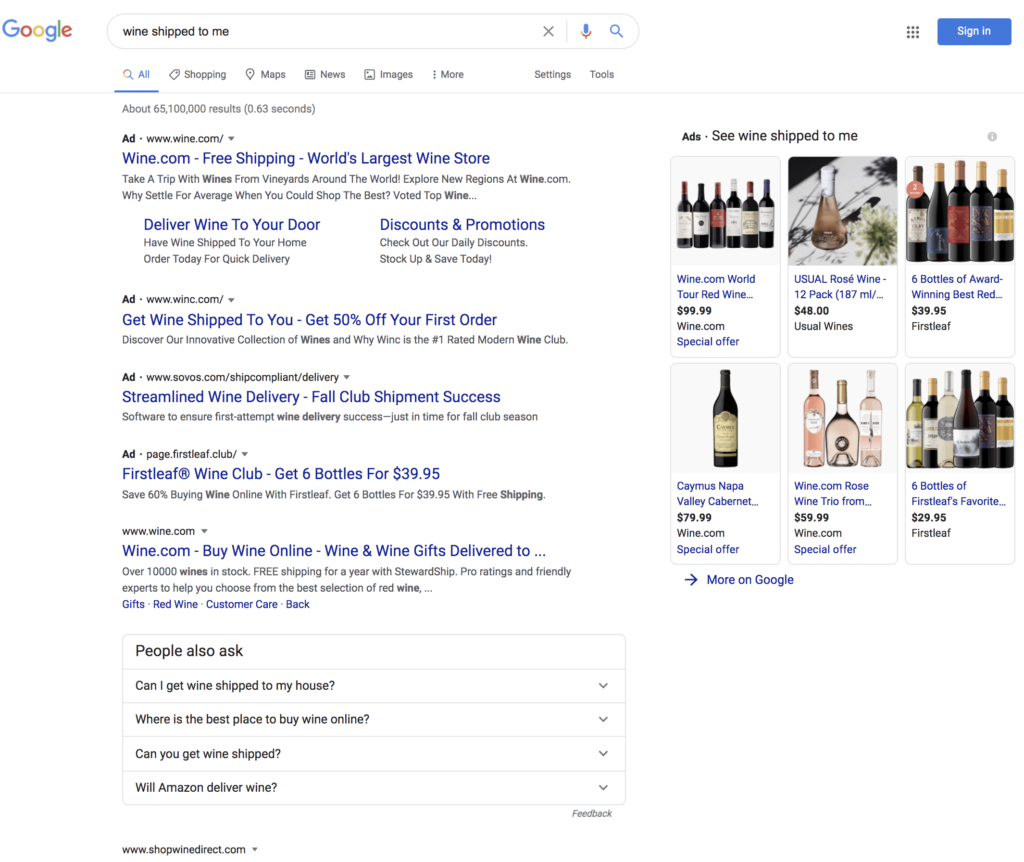
Let’s take a look at Winc and FirstLeaf.
Winc’s Wine Quiz
There are six different Call-to-Actions on the homepage to take the Palate Profile.

It is the easy, one-minute path to “discover the wine of your dreams”.
1 quiz.
6 questions.
And millions of people who are customers (including Karlie Kloss).
The landing page is uncluttered and clean, which directs the visitors to the quiz. this is the primary intent of the homepage — get users to take the quiz, share their taste preferences, and opt in with an email.
The Good:
Simplicity
As promised on the homepage, the quiz is straightforward and quick. Text-based, these are questions that don’t require thought. However there is also context of why these questions are asked, so that we understand the context and reason for the question.
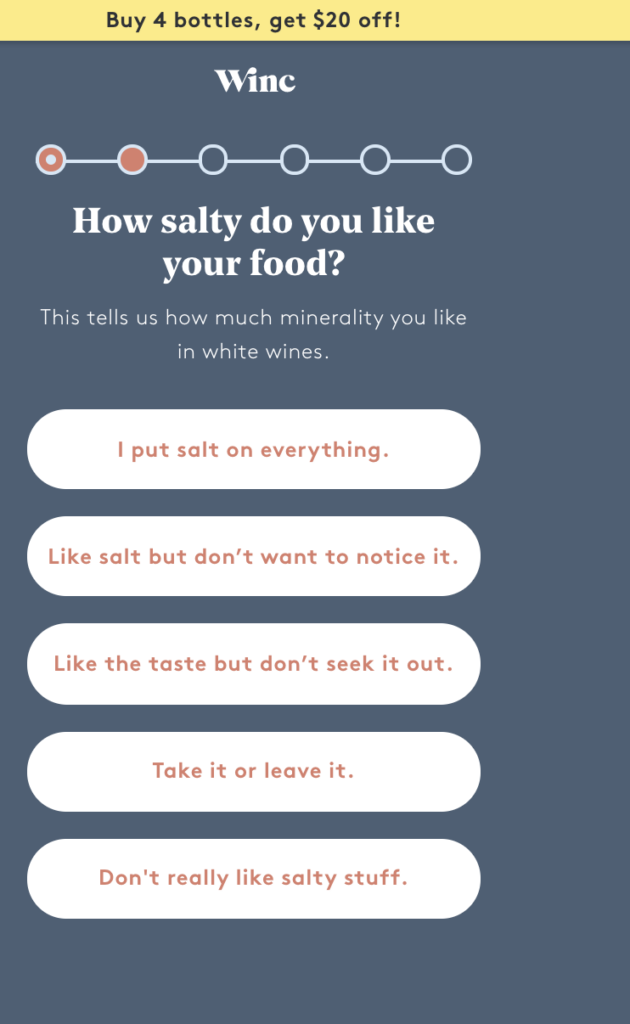
The Incentive (ie reminder of discount at the end)
The sticky bar reminds us that there is a “prize” at the end of this — a $20 discount. This is important, particularly on the email opt in page when I am prompted to enter my email or social profiles.
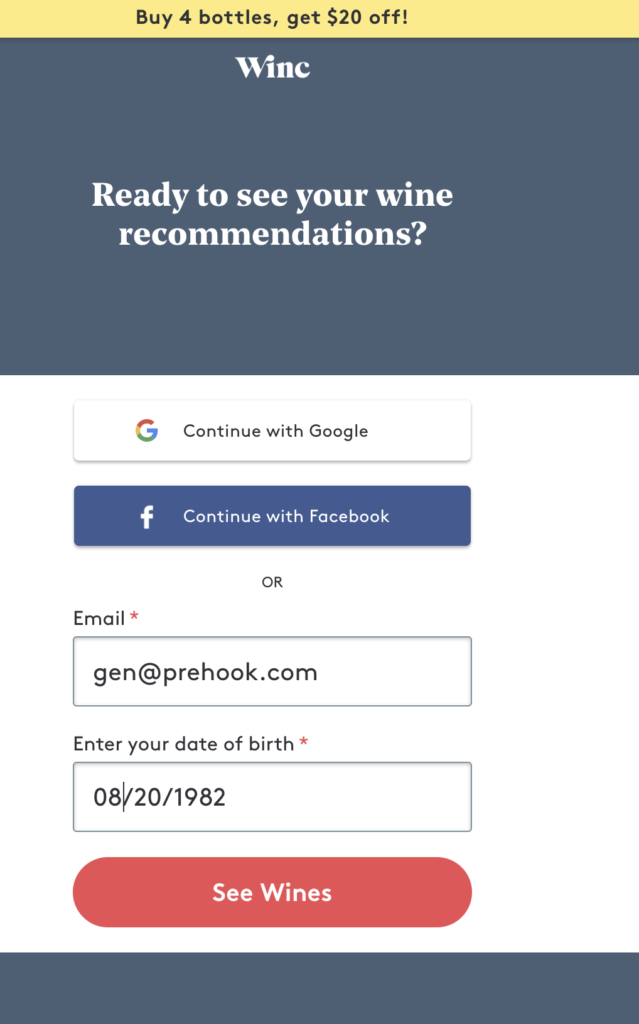
The Checkout Experience
The check out page beautifully elegant and well-structured (could that also sound like the description of a wine)?
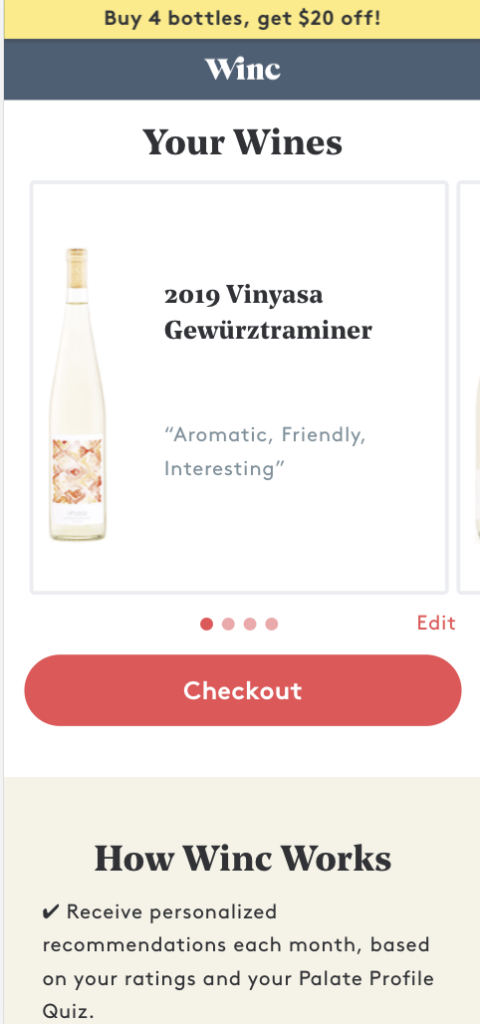
The wines are described in simple language, with three adjectives that are accessible and enticing. “Perfumed, rich, aromatic”. Yes, please!
Additionally, this is a great experience on mobile….
Instead of a shopper having to scroll up and down to see the wines, it is a carousel.
This allows the “Checkout” button to be ever present and easier to click. Less friction → more conversions!
The Email Follow Ups
I did not check out immediately from Winc, because I was also curious to see how they followed up with “abandoned carts”. In this case, I am defining anyone that completes the quiz and enters an email address as an abandoned cart.
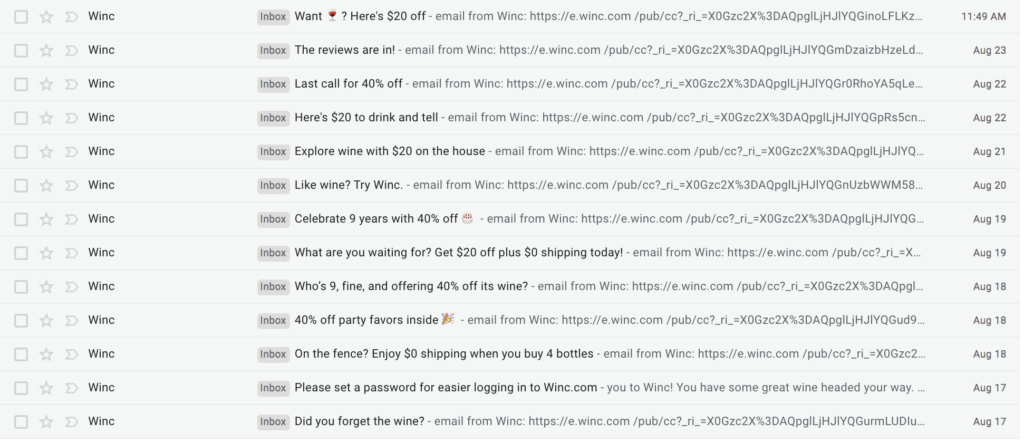
Winc’s email campaigns can be improved dramatically if they leveraged the data from the quiz.
Instead, many of the emails lead with a discount. Instead, they have the data, adn the opportunity, to speak to me as an individual, making an offer about the specific type of bottle that meets my criteria.
Out of all of these emails within a week of completing the quiz, there is no mention of anything specific to my quiz results. This defeats the purpose of the quiz.
Firstleaf
Now let’s check out the Firstleaf quiz.
Firstleaf drives the homepage traffic to the quiz, just as Winc does.
But here’s their interesting twist:
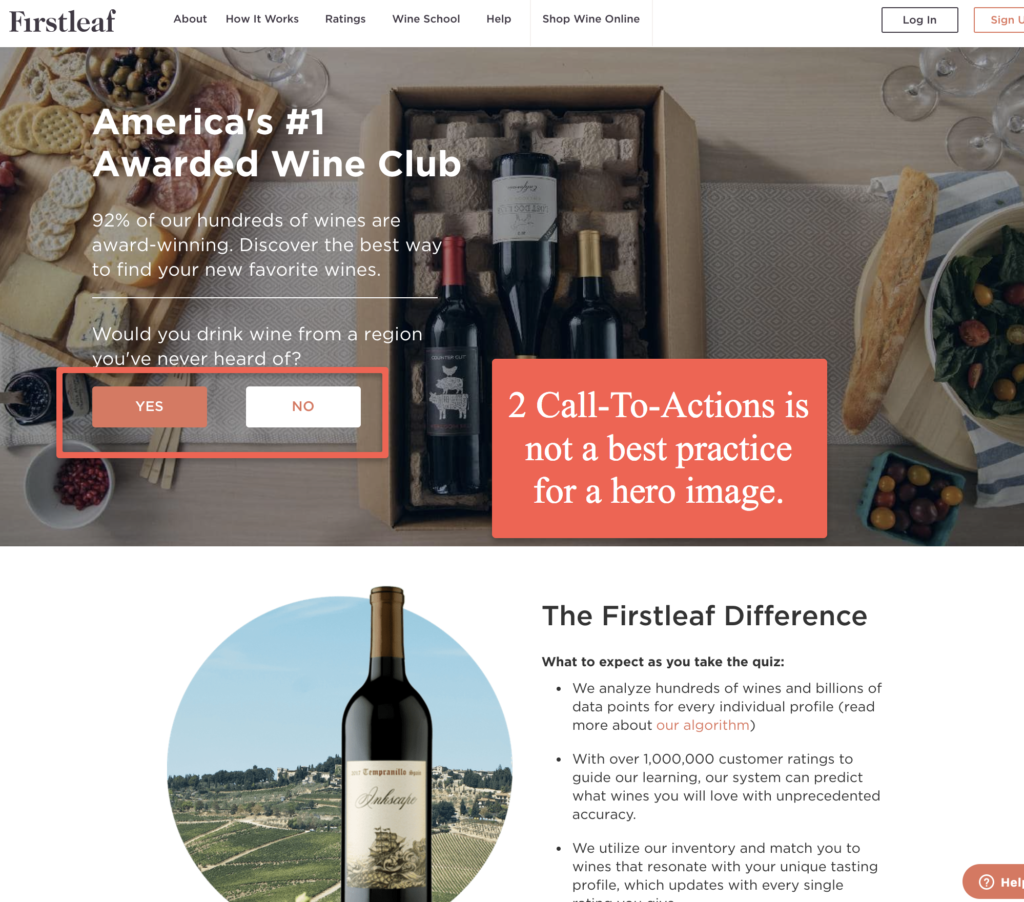
Normally, best practice for a user experience is to have one singular call to action. Any more than that, and the user is made to think, and this can reduce the likelihood of completing any action.
But Firstleaf has two call to actions on their hero image.
And guess what? They both go to the same Quiz page.
Here is the rationale behind that: they are getting micro-commitments from shoppers.
By posing a simple and non-invasive question, they are priming visitors to answer questions. The question, “Would you drink wine from a region you’ve never heard of?”, plays at our curiosity and desire to learn more about ourselves and wine.
The curiosity that is invoked, and the nonthreatening positioning of the question make us more likely to click the button….and start the quiz, which is the main goal!
The Good
Interactive Elements
This custom graphics change as you move the slider. It is very slick, and definitely has me playing around with it. This is in contrast to Winc’s shorter version (half the length) and more simplistic layout (all answers were text-based).
Explanation and “Why”
The quiz includes short sentences that are educational and interesting. This helps keep me engaged, and explain the context of why the question is being asked. For example, I did not know that the Pinot Grigio and Pinot Gris are made from the same grape but stylistically different. Interesting! This makes me want to continue learning in this simple and easy way.
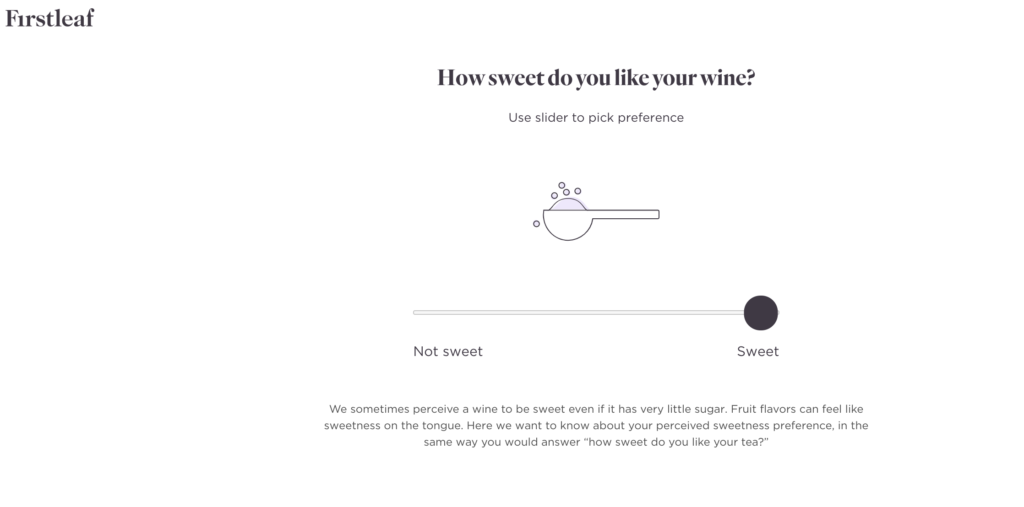
The Results Page
The results page is extremely text-heavy. In fact, take a look at this, the description of the wine:
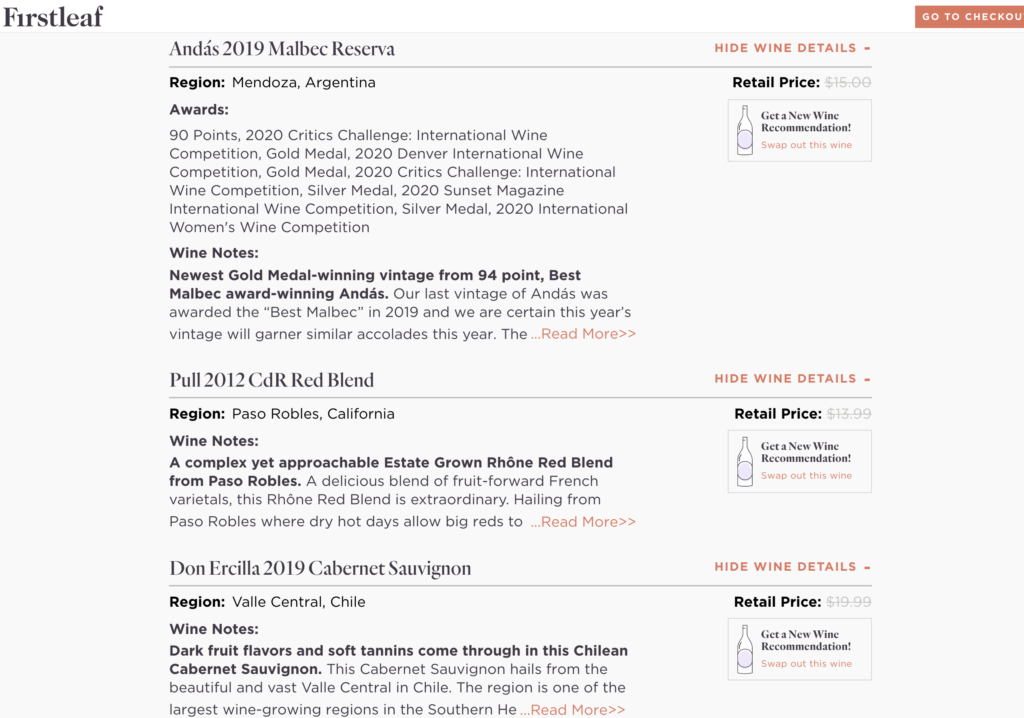
The awards are overkill, and don’t mean much to me, the novice wine drinker. While good for reinforcing the value and credibility of the offering, this page could be simplified and edited to make it more about the wine and less about the award.
The Value
OK, here is where Firstleaf is making an offer that is extremely enticing: 6 bottles for $39.95 (saving $62.02), free shipping, and a money back guarantee. I’d normally pay 2x that for a bottle, and have to go in person a store (not ideal in quarantine), and buy something off the shelf without any idea if I’d like it.
I’m enticed…..
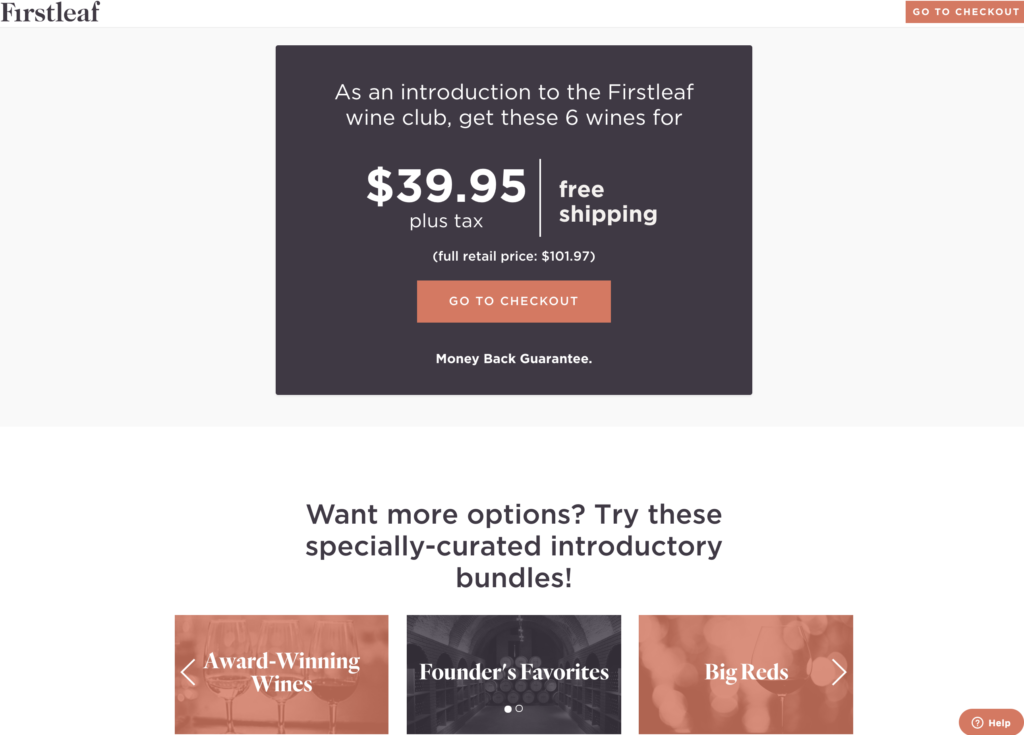
The Email Experience
Firstleaf sends just a fraction of emails that Winc does. In the week since completing the quiz, they sent 4 emails: a discount, a reminder, an offer of free shipping, and an email from the founder.

Firstleaf has information on what types of flavors and wine I like, but the emails are generic. Everyone who completes the quiz likely gets the exact emails that I did (the link the emails did go to the “Results” page though which directs to my selected wines).
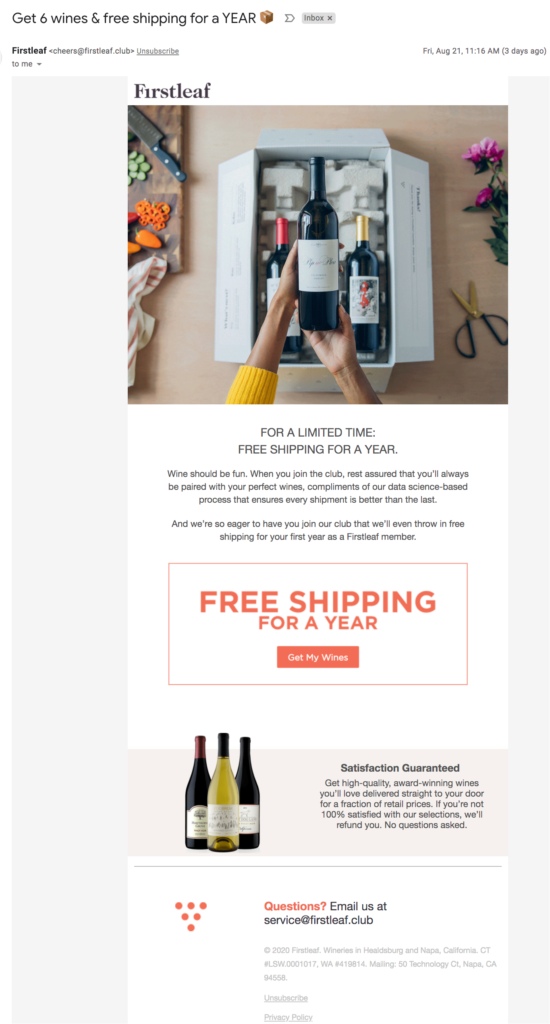
Winc’s Unit Economics
Winc raised a Series D on SeedInvest earlier in 2020, so many of their financials were made public. Some relevant numbers:
- CAC: $48
- LTV: $173 (in 2019)
- Gross margin of 69% in 2018
- 3.5x ROI on digital ad spend
- 542k customers (lifetime)
- AOV: NA (assume $50–based on the standard first order is $35, and some people may buy an extra few bottles)
- Assume that an average click costs $2
What can we learn from this?
1. Winc is acquiring at a break-even point – Winc does not disclose its Average Order Value, but assume it is around $50. The first box of 4 bottles is about $35, and some may order additional bottles. Winc thus relies on repeat orders to
2. Customers order ~3 times in their lifetime – if the Average Order is $50 and the Lifetime Value of the customer is $173, then customers order 3.5x on average.
3. Winc needs more repeat orders to hit profitability – per its disclosure: “The company has operated at a loss since inception and historically raised additional capital and borrowed funds to meet its growth needs. Profitability will come from more repeat orders from existing customers (increase the number of orders from 3.5). Additionally, using existing customers as a marketing channel is a cost-effective way to acquire new customers at a lower CAC.
The Takeaways
Makes Wine Accessible
The quiz funnel that Winc and Firstleaf use make wine accessible for young wine drinkers.
Winc in particular is focused on capturing the Gen Z and Millennial market, who may not have the experience, knowledge, and willingness to spend that older demographics do.
So the quiz makes it easy to learn about wine. It’s the entry point to attract the younger demographics that have been elusive to the wine industry: “We directly target millennials and Gen-X (over 80% of our member base), a demographic that traditional wineries have trouble reaching….The largest consumer group in the market sector, at 73M strong, Millennials tend to value transparency, quality, experience, and convenience above all when determining loyalty toward a product or service.”
Capture Leads — informs remarketing, email, and what offers matter
In completing just one quiz, in under a minute and 6 questions, I’ve provided a lot of valuable hints to Winc in who I am, what I’m looking for, and how they can communicate with me.
By completing the quiz and entering my email address, I initiate a relationship with the brand.
This relationship continues by email:

Facebook remarketing:
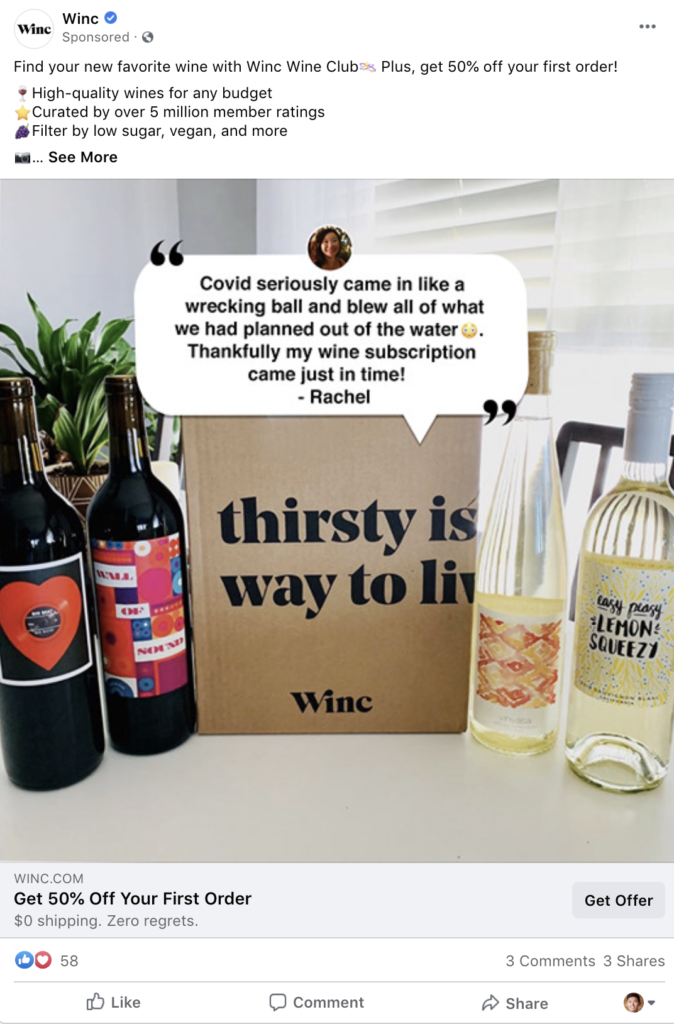
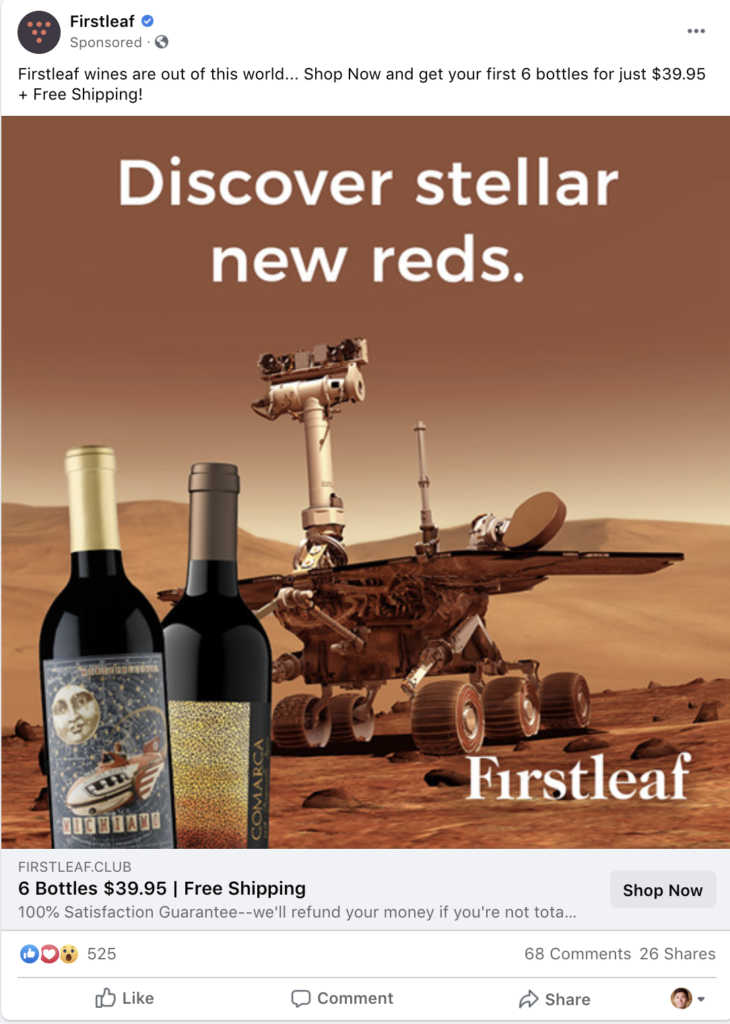
Accumulate Data
eCommerce wine brands will succeed based on the data set that they collect.
This includes the database of customers and leads, but more importantly, their preferences and feedback to the products.
This is why Winc describes itself as a data-driven winery: they create the exact wines that customers want to drink. These are the “consumer-led brands”, and its has grown quickly. Winc notes, “In the four years since we began creating our own wines, revenue has grown 333%.
We have created a diverse portfolio of consumer-led brands. We’ve produced 664 wines from 78 grape varieties, and 97 regions across 12 different countries.”
The quiz acts as a Master Sommelier–asking simple questions, and running through a catalog of thousands of wine bottles to present the perfect recommendation.
And the best part is that the recommendations improve in nature over time, building upon each point of feedback. That is where the personalized experience drives loyalty, repeat purchases, and higher lifetime value.
Cheers to that!
Want a quiz like Winc to build your customer base and drive sales?
We’re busy building it now–interactive quizzes to delight your customers with personalized recommendations.
Sign up to get early access!

